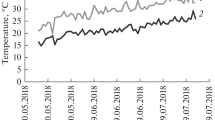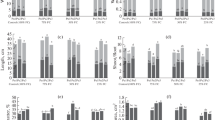Abstract
The endangered Himalayan plant Podophyllum hexandrum syn. P. emodi is inherently slow growing. The plants exhibit delayed emergence of functional leaves or hypocotyl dormancy. However, on GA3 treatment the functional leaves were found to emerge at a favorable temperature of 25°C in a higher percentage of seedlings and in a shorter time. Functional leaves emerged even at 10°C, a temperature when hypocotyl dormancy generally prevails. A considerable increase in the biochemical parameters related to carbon and nitrogen metabolism [starch, sugars and soluble nitrates, α-amylase and nitrate reductase (NR) activity], respiration and total dehydrogenase activity in all the seedling parts also indicated an enhancement of metabolic processes as influenced by GA3, for further growth and development. Specific leaf area of the green cotyledonary leaves increased at 25°C, probably to meet the carbon and nitrogen requirements for new structure formation. Higher activity of enzymes involved in carbon and nitrogen metabolism, i.e., NR and α-amylase especially at Hbn, the region of leaf meristematic activity, was further indicative of higher metabolism for earlier initiation of rapid vegetative growth. Initiation of reserve accumulation was also observed at 25°C.


Similar content being viewed by others
Abbreviations
- DNS:
-
3,5-Dinitro salicylic acid
- LMD:
-
Leaf mass density
- LMR:
-
Leaf mass ratio
- NEED:
-
N-(1-Napthyl) ethylene-diamine dihydrochloride
- NR:
-
Nitrate reductase
- RS:
-
Reducing sugar
- RGR:
-
Relative growth rate
- RMR:
-
Root mass ratio
- SMR:
-
Shoot mass ratio
- SLA:
-
Specific leaf area
- TDH:
-
Total dehydrogenase
References
Adams CA, Rinnie RW, Fjerstad MC (1980) Starch deposition and carbohydrates activity in developing and germinating soybean seeds. Ann Bot 45:577–582
Amthor JS (1989) Respiration and crop productivity. Springer, Heidelberg
Atkin OK, Day DA (1990) A comparison of the respiratory processes and growth rates of selected Australian alpine and related lowland species. Aust J Plant Physiol 7:517–526
Atkins OK, Botman B, Lambers H (1996) The causes of inherently slow growth in alpine plants: an analysis based on the underlying carbon economies of alpine and low land Poa species. Funct Ecol 10:698–707
Bernfield P (1955) Amylase, alpha and beta. Methods Enzymol 1:149–158
Emery RJN, Pearce DW, Pharis RP, Reid DM, Chinnappa CC (2001) Stem elongation and gibberellins in alpine and prairie ecotypes of Stellaria longipes. Plant Growth Regul 35:17–29
Fujii Y (1991) Podophyllum spp. In vitro regeneration and production of podophyllotoxins. In: Bajaj YPS (ed) Biotechnology in agriculture and forestry, medicinal and aromatic plants. Springer, Heidelberg, pp 362–375
Gojon A, Passard C, Bussi C (1994) Root/shoot distribution of NO3—assimilation in herbaceous and woody species. In: Roy R, Garnier E (eds) A whole plant perspective on carbon–nitrogen interactions. SPB Academic Publishing, The Hague, pp 131–147
Kamil WM, Dewick PM (1986) Biosynthetic relationships of aryltetralin lignans to dibenzylbutyrolactone lignans. Phytochemistry 25:2093–2102
Kharkwal AC, Prakash OM, Bhattacharya A, Ahuja PS (2004) Mass propagation and conservation of Podophyllum emodi Wall, an endangered medicinal plant of the Himalaya. Plant Genet Resour 2(1):51–57
Körner CH (2003) The alpine plants life. Springer-Verlag, Berlin
Lattanzi FA, Schnyder H, Thornton B (2005) The sources of carbon and nitrogen supplying leaf growth. Assessment of the role of stores with compartmental models. Plant Physiol 137:383–395
Lerndal T, Svensson B (2000) A clinical study of CPH 82 vs. methotrexate in early rheumatoid arthritis. Rheumatology 39:3–16
Loveys BR, Scheurwater I, Pons TL, Fitter AH, Atkin OK (2002) Growth temperature influences the underlying components of relative growth rate: an investigation using inherently fast and slow-growing plant species. Plant Cell Environ 25:975–987
Maksymowych R, Cordero RE, Erickson RO (1976) Long-term developmental changes in Xanthium induced by gibberellic acid. Am J Bot 63:1047–1053
Miller GL (1959) Use of dinitrosalicylic acid reagent for the determination of reducing sugar. Anal Chem 31:426–428
Nayar MP, Sastry APK (1990) Red data book of Indian plants. Botanical Survey of India, Calcutta
Olsen SC, Larsen HO (2003) Alpine medicinal plant trade and Himalayan mountain livelihood strategies. Geogr J 169(3):243–254
Pandey S, Misra SK, Kumar N (1998) Post harvest changes in excised Piper betle L. leaf: temporal changes in betel types bangla and kapoori. Indian J Exp Biol 36:95–98
Pollock CJ, Lloyd EJ, Stoddart JL, Thomas H (1983) Growth, photosynthesis and assimilate partitioning in Lolium temulentum exposed to chilling temperatures. Physiol Plant 59(2):257–262
Purohit AN, Nautiyal MC (1986) Inhibitory effect of cotyledons on plumule development in two alpine rosettes. Can J Bot 66:205–206
Singh DK, Hajara PK (1996) In: Gujral GS, Sharma V (eds) Changing perspectives of biodiversity status in the Himalaya. British Council Division, New Delhi, pp 23–38
Staheliin HF, Von Warburg A (1991) The chemical and biological route from podophyllotoxin glucoside etoposide. Cancer Res 51:5–15
Stewart GR, Orebamjo TO (1979) Some unusual characteristics of nitrate reduction in the tropical leguminous tree Erythrina senegalensis DC. New Phytol 83:311–319
Acknowledgement
The authors acknowledge the financial assistance obtained from the National Bioresource Development Board, Department of Biotechnology, Government of India, New Delhi.
Author information
Authors and Affiliations
Corresponding author
Additional information
IHBT Communication No. 508b
Rights and permissions
About this article
Cite this article
Kushwaha, R., Pandey, S., Chanda, S. et al. GA3 induced changes in slow growing endangered Himalayan plant Podophyllum hexandrum and hastening of vegetative growth. Plant Growth Regul 51, 207–215 (2007). https://doi.org/10.1007/s10725-006-9161-z
Received:
Accepted:
Published:
Issue Date:
DOI: https://doi.org/10.1007/s10725-006-9161-z




